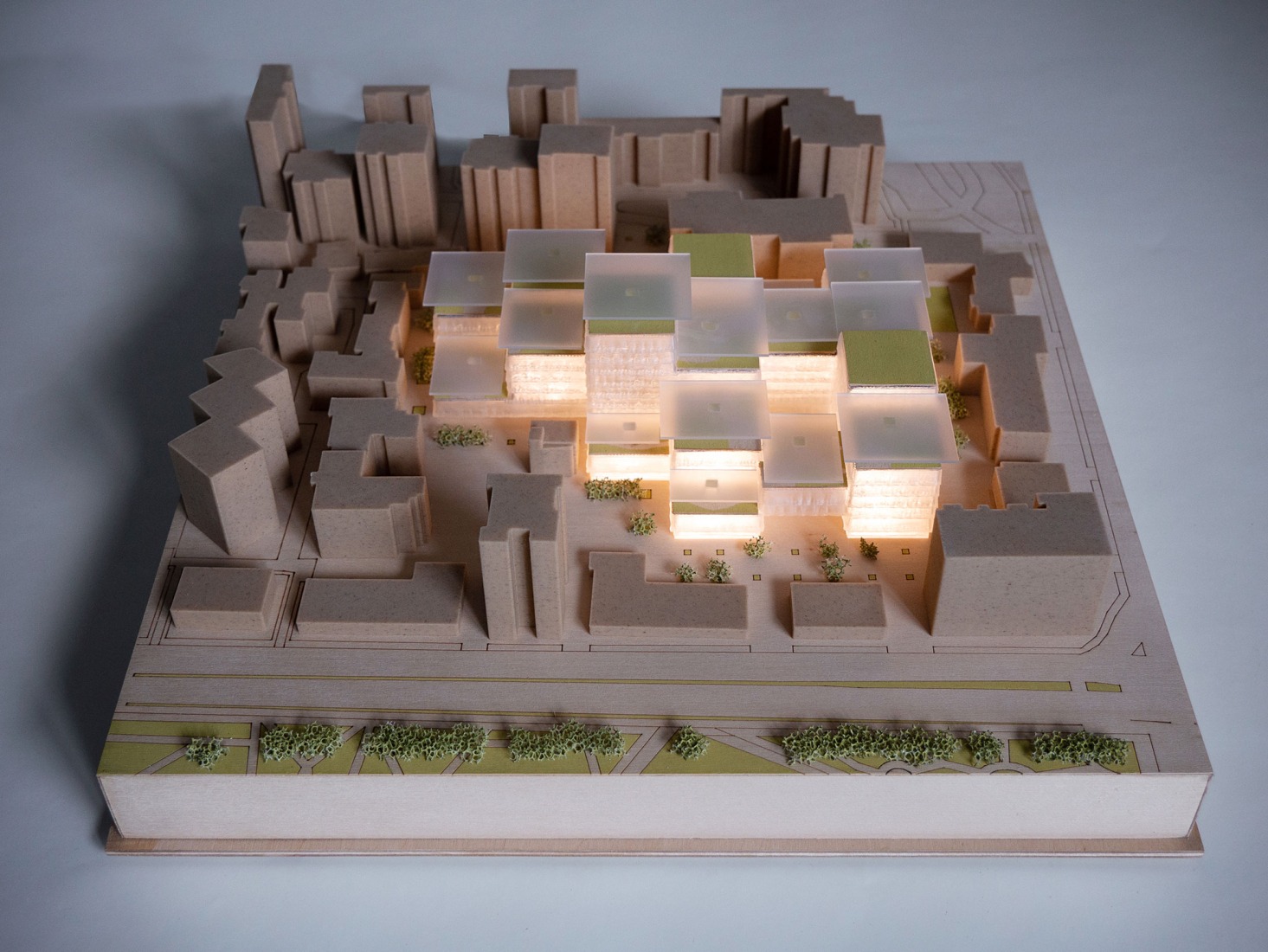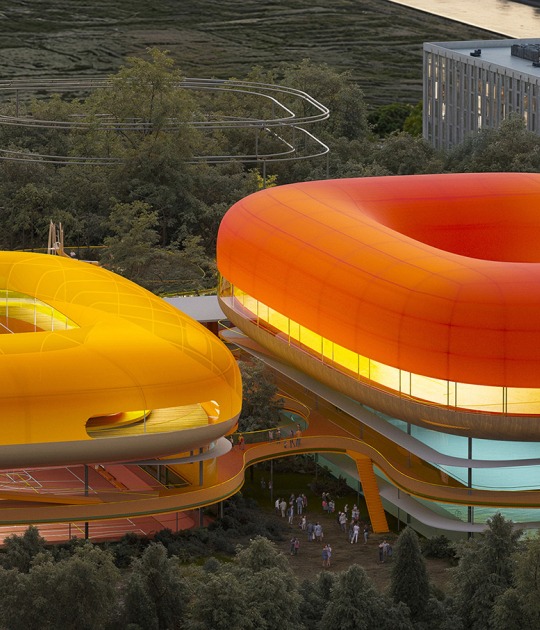
The new Public Administration complex developed by Coldefy will occupy 31,000 square meters built above ground level, as well as providing the neighborhood with new underground parking and services. The project is designed with future adaptability in mind, ensuring flexibility for changing work environments and relationships between the public and private spheres.
The complex seeks to foster a deeper connection between citizens and public institutions, as it will house a variety of government institutions and public facilities in a space that connects directly to the city. The ground floor will be fully open and accessible, offering plazas, commercial spaces and landscaped courtyards that seamlessly connect the interior and exterior of the complex.
“Our vision was to create a space that not only houses the administration, but also symbolizes the collective values of society. The project gives space back to the community, reflecting transparency and coexistence with the public administration. It not only improves the workspace for employees, but also enhances the surrounding neighborhood, fostering inclusion and community through welcoming public spaces.”
Coldefy.

Project Background
The Public Administration Complex will address a long-standing challenge in Tirana: the fragmented and inefficient distribution of government offices across multiple aging buildings throughout the city. Many of these buildings, some of which date back to the 20th century, are no longer compatible with the demands of modern administration, suffering from structural wear and tear resulting from the 2019 Albanian earthquake, and lacking the flexibility, infrastructure, and workspaces needed to support efficient government operations.
The Government of Albania, through the Albanian Investment Corporation (AIC), has developed a forward-looking strategy to consolidate these dispersed institutions into a single modern administrative complex. The initiative is part of a broader vision that seeks to energize Tirana’s urban landscape and administrative infrastructure.
The project is funded through a public-private partnership model, which benefits both public institutions, which gain new state-of-the-art facilities, and private investors, who receive access to prime commercial real estate in Tirana’s expanding business districts.
The government provides high-value properties for commercial redevelopment to private investors, who in turn fund the construction of modern government offices. This innovative strategy also stimulates the local real estate market by unlocking the untapped potential of government-owned properties and elevating the surrounding neighborhoods.

Connection to the City
The project adopts a comprehensive urban strategy projected to alleviate the pressures of a rapidly growing neighborhood while simultaneously improving the accessibility and connectivity of the area. Located in a district where urban congestion is a concern, the new Public Administration complex plays a pivotal role in creating open and accessible spaces that are as welcoming to the public as they are functional for government operations.
The project prioritizes pedestrian accessibility, fostering a sense of flow and openness that invites movement through the block rather than creating barriers. Open courtyards and plazas serve as communal gathering points, contributing to the neighborhood's vitality and encouraging public interaction with government spaces, allowing the administrative center to seamlessly blend into its surroundings.
In addition to these surface-level improvements, the project includes underground parking facilities that significantly reduce street-level congestion, freeing up public spaces for pedestrians and cyclists. This approach not only improves traffic flow, but also enhances the quality of life on the surrounding streets by making them safer and more walkable.

By respecting the scale and character of the existing urban fabric, the building avoids dominating the skyline while still offering modern, high-quality administrative services. This approach balances the changing needs of Tirana with a sensitivity to its historical and architectural context, ensuring that the new development enhances, rather than disrupts, the existing neighbourhood. As well as allowing for the creation of rooftop gardens and outdoor spaces, which provide additional exchange spaces that blend nature with urban life, further enhancing the accessibility and inclusivity of the project.
“The inspiration comes from a close study of Albanian culture, especially the textile art that defines the local traditional costumes. Here, the architecture is created together with its “mantle”, an approach that goes beyond decoration, always aware of how it looks from the outside, admired by Tirana, who will come to see them as their own.
The thousands of polycarbonate rods, unique hand-made pieces, linked together form light structures that rest gently on the volumes, blend with the vegetation and spread across the terraces. The transparent polycarbonate, carefully chosen to reflect the iconic Albanian hues, is softly reflected throughout the building, shimmering in sunlight or evening lights, spreading its vibrant warmth across the surrounding area.”
Jacopo Foggini.

The integration of art and architecture is central to the project’s design, which showcases a collaborative effort that transforms the administrative complex into a cultural landmark.
In collaboration with Italian artist Jacopo Foggini, the project draws inspiration from Albania’s rich tradition of colour and craftsmanship. The façade design, influenced by traditional Albanian clothing such as the fustanela, is wrapped in a perforated and undulating white metal mesh that offers sun protection and maintains visibility. This delicate layer contrasts with the dense urban environment, giving the building a unique identity that is both protective and welcoming. Hand-made polycarbonate rods, inspired by traditional textiles, meander through the building from the ground floor to the roof, serving as both a visual statement and functional elements, including signage and sun protection for the terraces. These vibrant rods add warmth, creating a harmonious link between Albania’s cultural heritage and the building’s modern architecture.
This artistic intervention elevates the building beyond its functional purpose, turning it into a symbol of civic identity and cultural expression. Rather than simply housing government offices, the structure becomes a living work of art that invites interaction and contemplation from passersby and visitors alike. The polycarbonate rods shimmer and move with the changing light, adding a dynamic element to the façade and reinforcing the building’s role as a public landmark.
By integrating art so seamlessly into its architectural form, the project fosters a deep sense of civic pride and cultural engagement. The building is not just a space for administration; It is a place where the public can connect with the heritage and artistic spirit of their city. This approach ensures that the complex contributes not only to Tirana’s administrative efficiency, but also enriches its cultural and urban landscape, serving as a point of pride and engagement for the entire community.

Flexibility and efficiency are central to the success of the Public Administration complex, especially given its role as a public-private investment. These principles ensure that the project not only meets the immediate needs of the government administration, but also provides long-term value for both public institutions and private stakeholders. The building project incorporates a number of environmentally friendly features, such as rainwater harvesting systems, landscaped courtyards for natural cooling, and vegetated rooftop terraces. These elements work together to provide shade, reduce the urban heat island effect, and improve the building’s environmental efficiency, making it a key contributor to Tirana’s ecological resilience.
The modular system at the heart of the project not only ensures flexibility between the various administrative departments, but also supports future uses that can generate additional economic value for the site. The ability to easily adapt the building layout allows for independent and safe operation in different areas, making it versatile for both public and residential uses.
The modular system at the heart of the project not only ensures flexibility between the various administrative departments, but also supports future uses that can generate additional economic value for the site. The ability to easily adapt the building’s layout allows for independent and safe operation in different areas, making it versatile for both public and private uses.

In addition, the modular design prioritises economic efficiency by delivering high-quality architecture whilst minimising complexity, helping to ensure that financial, construction, operational and maintenance objectives are met. This makes the building a cost-effective investment, able to adapt to changing demands over time.
Resource efficiency is also a key focus. Native plants in the courtyards and roof gardens not only reduce water use, but also promote local biodiversity, providing serene green spaces for employees and visitors. The rainwater harvesting system further supports sustainability, reducing the building’s reliance on municipal water supplies and contributing to Tirana’s water conservation efforts.
Advanced materials and technologies also play a role in optimizing energy efficiency. Passive design strategies such as natural ventilation and strategically placed sunshades (integrated with the polycarbonate rods that also serve as an artistic element) help regulate temperatures within the building, reducing the need for mechanical heating and cooling.

Together, these strategies ensure that the Public Administration complex is not only environmentally sustainable, but also highly efficient and adaptable. This balance of flexibility, sustainability, and economic efficiency reinforces the project’s success as a public-private investment, delivering lasting benefits for both public institutions and private stakeholders, while ensuring the long-term value of the site.
The competition jury, headed by José Selgas, co-founder of SelgasCano, praised the project for its thoughtful integration into the urban fabric. They highlighted the balance between functionality, flexibility, and a modest presence within the city landscape, stating: “The jury appreciates that the office building has many terraces, courtyards, and public spaces integrated throughout the plan. The city administration does not impose itself on the urban texture, but it has a modest presence. The organization offers plenty of flexibility for its uses to evolve over time, as well as admirably economical construction costs. And yet, it is not an anonymous office.
The competition
The international competition for the Public Administration Complex in Tirana, organized by the Albanian Investment Corporation, followed a two-phase process. In the first phase, a pre-qualification round was held to select the best international architectural firms. The shortlisted teams then advanced to the second phase, where they presented their innovative design concepts. The goal of the competition was to create a flexible and future-proof administrative center that would consolidate government services while supporting Tirana’s urban development and sustainability initiatives.
The competition attracted leading global architectural talent, with notable entrants including EMBT Architects, SNOHETTA, ANDREA CAPUTO + SO-IL, and ZAHA HADID Architects.



























































